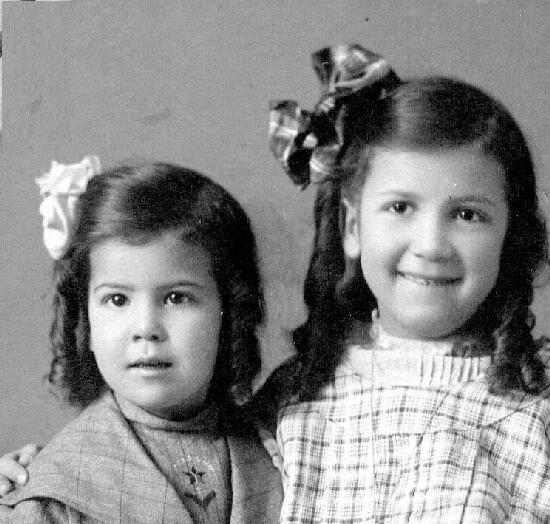
Hair Bows for Boys: Patterns

Figure 1.--These children were photographed in Salem, C (Connecticut) about 1905. The little boy has a white hairbow and his sister a plaid hairbow. We have no idea on what basis this selection was made. Note that both children have identical ringlet hair styles. The boy's ringlets are shorter, perhaps because he was younger and his hair was not a long as his sister's hair. Click on the image for more information about the children. Image courtesy of the RG collection.
|
Although not nearly as common as solid color hair bows, children also wore patterened hair bows. We have noted both plaid and polka-dot pattern hair bows. There may have been other hair bow patterns as well. We have not noted boys commonly wearing the patterened hair bows. This may be because there are far fewer images of boys wearing hair bows than girls. We are not sure that this was attributable to gender connotations. We do note boys wearing patterened collar bows. This suggests to HBC that there was no gender conventions associated with patterened hair bows. A HBC reader comments, "I think you are correct in concluding that boys wore white or what appears white hair bows. I know of only a few instances of boys wearing patterns hair bows and in those cases it looked like a match to their collar bows." We note phoograph of children with both solid and pattern hairbows, but are not sure on what basis a solid color hairbow was selected for one child and a patterned hairbow for the other (figure 1). There are a variety of possibilities here. Some mothers may havenot given much thought to the selection, but given how carefully many of these children are outfitted, we do not think this very likely. Mothers may have had favorite colors. Perhaps the children did also. Perhaps they were matching the color or pattern of clothes. Note here that the girl is wearing a plaid pinafore with a plaid hairbow. The children's eye color may have also been a factor. Selecting different colors or patterns might have been a way of differentiating sons and daughters. And as our reader mentions, some mothers mat have wanted to coordinate collars or other bows the children were wearing.
Popularity
Although not nearly as common as solid color hair bows, children also wore patterened hair bows. We have no precise estimates from period sources. The photographic record, however, suggests that the solid colored hair bows were much more common. We have no way of knowing how representative or sample is, but there are a growing number of images archived on HBC and we have noted a relatively small number of patterened hairbows.
Patterns
We have noted both plaid and polka-dot pattern hair bows. There may have been other hair bow patterns as well. Westill have only limited information on these patterns.
Gender Conventions
We have not noted boys commonly wearing the patterened hair bows. This may be because there are far fewer images of boys wearing hair bows than girls. We are not sure that this was attributable to gender connotations. We do note boys wearing patterened collar bows. This suggests to HBC that there was no gender conventions associated with patterened hair bows. A HBC reader comments, "I think you are correct in concluding that boys wore white or what appears white hair bows. I know of only a few instances of boys wearing patterns hair bows and in those cases it looked like a match to their collar bows." We note photographs of children with both solid and pattern hairbows, but are not sure on what basis a solid color hairbow was selected for the boy and a patterned hairbow for the girl (figure 1).
Selection Process
There are a variety of possibilities here. Some mothers may havenot given much thought to the selection, but given how carefully many of these children are outfitted, we do not think this very likely. Mothers may have had favorite colors. Perhaps the children did also. Perhaps they were matching the color or pattern of clothes. Note here that the girl is wearing a plaid pinafore with a plaid hairbow. The children's eye color may have also been a factor. Selecting different colors or patterns might have been a way of differentiating sons and daughters. And as our reader mentions, some mothers mat have wanted to coordinate collars or other bows the children were wearing. While the girl's hairbow may match her pinafore, the boy's white hair bow does not match his sailor outfit (figure 1). White was, however, a color that both boys and girls could wear with any color or clothing pattern.
Christopher Wagner

Navigate related Boys' Historical Clothing Web Site pages:
[Return to the Main boys' hairbow color page]
[Hair styles]
[Collar bows]
[Dresses]
[Kilt suits]
[Kilts]
[Fauntleroy suits]
[Fauntleroy dresses]
[Sailor dresses]
[Pinafores]
[Smocks]
Navigate the Boys' Historical Clothing Web Site:
[Introduction]
[Activities]
[Biographies]
[Chronology]
[Clothing styles]
[Chronology]
[Bibliographies]
[Contributions]
[Essay]
[FAQs]
[Glossaries]
[Satellite sites]
[Tools]
[Boys' Clothing Home]
Created: January 11, 2003
Last updated: January 12, 2003



